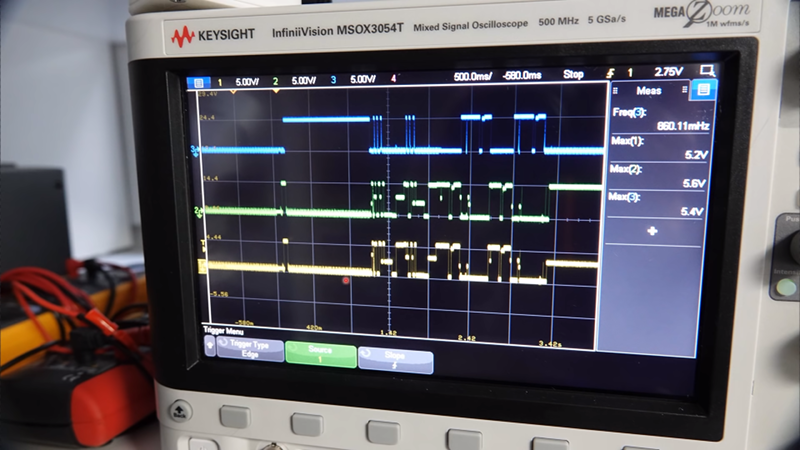Most people have at least seen those cheap component testers you can buy on the Chinese websites for $10 or so. If you haven’t seen them before, they usually have some kind of multi pin socket. You put a component in the socket and it will identify — with a push of a button — what the part is, which pin is which, and the value of the part. For example, you can insert a resistor, a capacitor, an inductor, a diode, or a transistor and get a readout of which pin is which. It seems like magic, but [Andreas Spiess] did the research on how it all works and summed up his findings in a recent video.
[Andreas] even quotes our earlier post on the topic and, as we did, dug into the original developers of the device which has been cloned over and over by Chinese sellers. Although there have been some divergence with all the different versions, the basic idea is the same. An AVR CPU uses some analog and digital trickery to make a lot of different measurements.
There are quite a few coding tricks you can learn by examining how the testers can do the job with very few external components. It also helps to go to the original project. Just be careful. Your $7 tester from eBay might not be able to work with the original code — some makers do simple modifications for different displays or other reasons.
We’ve seen these hacked to do other things, although maybe nothing as useful as the original. More fun perhaps, but not as useful.
















As many others I also love this little tester.
Bought a bunch of them, some with just the intention to repurpose the graphic LCD and uC for other projects (as also mentioned here).
One extra point worth highlighting is the power supply circuit.
Andreas very briefly mentiones it lasts “virtually forever” without the power switch he added, and rightly so.
Only power consumption after the device turned itself off is the leakage through a single bipolar resistor and I’m having dificulty measuring it accruately but is well below 1uA (200nA?) (but is also very termperature dependent).
Loose bipolar transistors tend to have lower leakage current then MOSfet’s, and using good old BJT’s is a good choice here.
Depends on the model. I had an older one with monochrome display which came as a PCB and you attached a 9V battery. The battery lasted a long time, true. It disintegrated after i dropped it.
So I bought a more modern one, it comes in a box, color LCD, rechargeable battery and has a higher voltage for zenner or LEDs. Problem is…it self discharges while being off in a couple of weeks. Way less useful.
I have made my variation that run on one AA rechargeable battery. I use a MCP1640 with built-in power switch and clean up the button circuit. Also modified the code for Chinese IR receiver pin out.
https://github.com/FPGA-Computer/component_tester
AFAIK these devices are clones of an FOSS-device developped on a german forum, so you can just read the code. https://www.mikrocontroller.net/articles/AVR_Transistortester (multi-language)
Ok, should have read the article more carefully. Nevermind.
Anybody else remember or have one of these? https://web.archive.org/web/20090130112233/http://m3electronix.com/sa.html
This was a commercial product available assembled or as a kit and pretty much the same idea but it used a PIC. A couple years or so before I ever had even heard of an AVR I saw these guys demonstrate their device at Dayton Hamvention and I just had to have one.
Later after mine stopped working and I saw that M3 had gone out of business I started googling for an alternative. I saw that there had been a construction article in a magazine some years before M3 released theirs. Maybe it was in Elektor? I don’t remember for sure what magazine. Anyway, I think the M3 guys based theirs on that or maybe even their founder was the one who wrote the article in the first place.
During that search I also found the German AVR Transistor Testor mailing list. Being an actively devloped open source project that already had more features than the old PIC one this was the obvious choice to go with vs ordering a back issue of a magazine and hoping the author still responds to requests to buy a copy of the firmware.
Before I got around to building that however the Chinesium shops started selling their own versions so that was that!
Anyway, I have since wondered if the AVR project was originally inspired by the old PIC based one or if it was just a case of convergent evolution. Anyone out there know?
I’ll just leave this here
https://www.elektormagazine.com/magazine/elektor-200504/17935
“How do they work?”
Quite fine, usually.
How does an electrical device “inherit engineering talent”?
By drawing blood.
class ElectricalDevice : public EngineeringTalent {}; //obviously
I have a game boy printer, and this crazy idea of hooking it up to mine and printing a screenshot, so I can have nice and easy labels for salvaged components.
The most microcontroller programming I have done is blinking LEDs in a chasing pattern, and unless I start salvaging many more it’s probably easier to keep labeling them by hand.